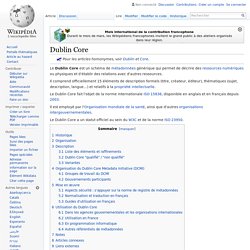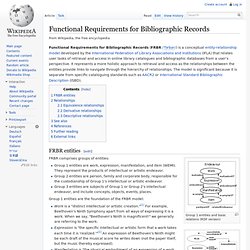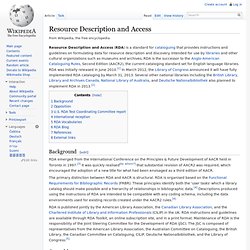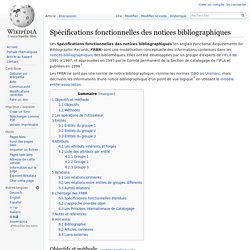

Dublin Core. Un article de Wikipédia, l'encyclopédie libre.

Le Dublin Core est un schéma de métadonnées générique qui permet de décrire des ressources numériques ou physiques et d’établir des relations avec d'autres ressources. Il comprend officiellement 15 éléments de description formels (titre, créateur, éditeur), thématiques (sujet, description, langue…) et relatifs à la propriété intellectuelle. Le Dublin Core fait l'objet de la norme internationale ISO 15836, disponible en anglais et en français depuis 2003. Il est employé par l'Organisation mondiale de la santé, ainsi que d'autres organisations intergouvernementales.
Le Dublin Core a un statut officiel au sein du W3C et de la norme ISO 23950. Historique[modifier | modifier le code] Le groupe de travail de mars 1995 a été commandité par l'Online Computer Library Center (OCLC) et le National Center for Supercomputing Applications (NCSA). Y participaient : Functional Requirements for Bibliographic Records. Functional Requirements for Bibliographic Records (FRBR /ˈfɜrbər/) is a conceptual entity-relationship model developed by the International Federation of Library Associations and Institutions (IFLA) that relates user tasks of retrieval and access in online library catalogues and bibliographic databases from a user’s perspective.

It represents a more holistic approach to retrieval and access as the relationships between the entities provide links to navigate through the hierarchy of relationships. The model is significant because it is separate from specific cataloguing standards such as AACR2 or International Standard Bibliographic Description (ISBD). FRBR entities[edit] Group 1 entities and basic relations (RDF version) Group 2 entities and relations FRBR comprises groups of entities: Group 1 entities are work, expression, manifestation, and item (WEMI). Group 1 entities are the foundation of the FRBR model: Work is a "distinct intellectual or artistic creation. Resource Description and Access.
Resource Description and Access (RDA) is a standard for cataloguing that provides instructions and guidelines on formulating data for resource description and discovery.

Intended for use by libraries and other cultural organizations such as museums and archives, RDA is the successor to the Anglo-American Cataloguing Rules, Second Edition (AACR2), the current cataloging standard set for English language libraries. RDA was initially released in June 2010.[1] In March 2012, the Library of Congress announced it will have fully implemented RDA cataloging by March 31, 2013. Several other national libraries including the British Library, Library and Archives Canada, National Library of Australia, and Deutsche Nationalbibliothek also planned to implement RDA in 2013.[2] Background[edit] RDA emerged from the International Conference on the Principles & Future Development of AACR held in Toronto in 1997.[3] It was quickly realised[by whom?]
Opposition[edit] U.S. International reception[edit] Spécifications fonctionnelles des notices bibliographiques. Un article de Wikipédia, l'encyclopédie libre.

Les Spécifications fonctionnelles des notices bibliographiques (en anglais Functional Requirements for Bibliographic Records, FRBR) sont une modélisation conceptuelle des informations contenues dans les notices bibliographiques des bibliothèques. Elles ont été développées par un groupe d'experts de l'IFLA de 1991 à 1997, et approuvées en 1997 par le Comité permanent de la Section de catalogage de l’IFLA et publiées en 1998[1]. Les FRBR ne sont pas une norme de notice bibliographique, comme les normes ISBD ou Unimarc, mais décrivent les informations d'une notice bibliographique d'un point de vue logique[2] en utilisant le modèle entité-association.
Objectifs et méthode[modifier | modifier le code] Objectifs[modifier | modifier le code] Méthodes[modifier | modifier le code] Les opérations de l'utilisateur[modifier | modifier le code] Le modèle FRBR prend en compte quatre opérations effectuées par ces utilisateurs[11] : NB. NB.